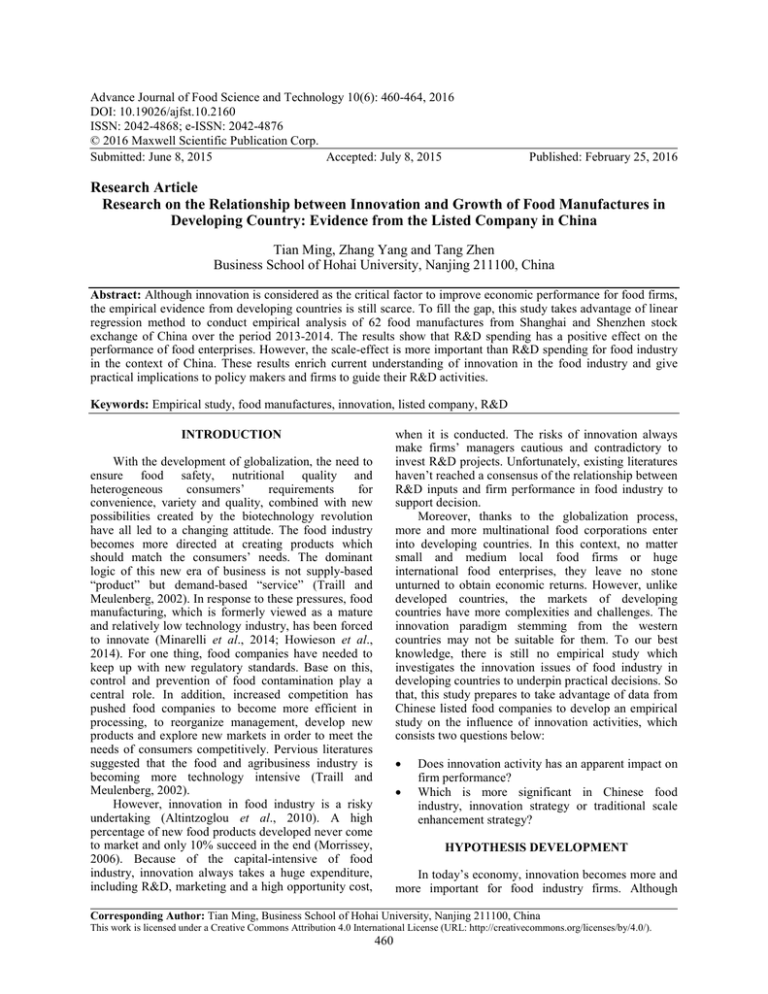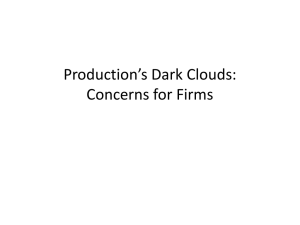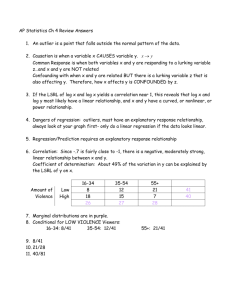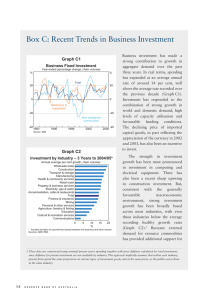Advance Journal of Food Science and Technology 10(6): 460-464, 2016
advertisement

Advance Journal of Food Science and Technology 10(6): 460-464, 2016 DOI: 10.19026/ajfst.10.2160 ISSN: 2042-4868; e-ISSN: 2042-4876 © 2016 Maxwell Scientific Publication Corp. Submitted: June 8, 2015 Accepted: July 8, 2015 Published: February 25, 2016 Research Article Research on the Relationship between Innovation and Growth of Food Manufactures in Developing Country: Evidence from the Listed Company in China Tian Ming, Zhang Yang and Tang Zhen Business School of Hohai University, Nanjing 211100, China Abstract: Although innovation is considered as the critical factor to improve economic performance for food firms, the empirical evidence from developing countries is still scarce. To fill the gap, this study takes advantage of linear regression method to conduct empirical analysis of 62 food manufactures from Shanghai and Shenzhen stock exchange of China over the period 2013-2014. The results show that R&D spending has a positive effect on the performance of food enterprises. However, the scale-effect is more important than R&D spending for food industry in the context of China. These results enrich current understanding of innovation in the food industry and give practical implications to policy makers and firms to guide their R&D activities. Keywords: Empirical study, food manufactures, innovation, listed company, R&D when it is conducted. The risks of innovation always make firms’ managers cautious and contradictory to invest R&D projects. Unfortunately, existing literatures haven’t reached a consensus of the relationship between R&D inputs and firm performance in food industry to support decision. Moreover, thanks to the globalization process, more and more multinational food corporations enter into developing countries. In this context, no matter small and medium local food firms or huge international food enterprises, they leave no stone unturned to obtain economic returns. However, unlike developed countries, the markets of developing countries have more complexities and challenges. The innovation paradigm stemming from the western countries may not be suitable for them. To our best knowledge, there is still no empirical study which investigates the innovation issues of food industry in developing countries to underpin practical decisions. So that, this study prepares to take advantage of data from Chinese listed food companies to develop an empirical study on the influence of innovation activities, which consists two questions below: INTRODUCTION With the development of globalization, the need to ensure food safety, nutritional quality and heterogeneous consumers’ requirements for convenience, variety and quality, combined with new possibilities created by the biotechnology revolution have all led to a changing attitude. The food industry becomes more directed at creating products which should match the consumers’ needs. The dominant logic of this new era of business is not supply-based “product” but demand-based “service” (Traill and Meulenberg, 2002). In response to these pressures, food manufacturing, which is formerly viewed as a mature and relatively low technology industry, has been forced to innovate (Minarelli et al., 2014; Howieson et al., 2014). For one thing, food companies have needed to keep up with new regulatory standards. Base on this, control and prevention of food contamination play a central role. In addition, increased competition has pushed food companies to become more efficient in processing, to reorganize management, develop new products and explore new markets in order to meet the needs of consumers competitively. Pervious literatures suggested that the food and agribusiness industry is becoming more technology intensive (Traill and Meulenberg, 2002). However, innovation in food industry is a risky undertaking (Altintzoglou et al., 2010). A high percentage of new food products developed never come to market and only 10% succeed in the end (Morrissey, 2006). Because of the capital-intensive of food industry, innovation always takes a huge expenditure, including R&D, marketing and a high opportunity cost, • • Does innovation activity has an apparent impact on firm performance? Which is more significant in Chinese food industry, innovation strategy or traditional scale enhancement strategy? HYPOTHESIS DEVELOPMENT In today’s economy, innovation becomes more and more important for food industry firms. Although Corresponding Author: Tian Ming, Business School of Hohai University, Nanjing 211100, China This work is licensed under a Creative Commons Attribution 4.0 International License (URL: http://creativecommons.org/licenses/by/4.0/). 460 Adv. J. Food Sci. Technol., 10(6): 460-464, 2016 innovation is more common when industry dynamism is high, innovative firms are likely to enjoy revenue growth, irrespective of the industry in which they operate (Thornhill, 2006). As a result, innovation is viewed as the success to the extent that it leads to a competitive advantage, consequent superior profitability and high loyalty from customers (Russo Spena and Colurcio, 2010; Roberts and Amit, 2003). Utterback and Abernathy (1975) indicate that there are two kinds of innovation can capture the former benefits, product innovation and process innovation. In terms of food industry, several researchers find that new food products are more successful in the market than line extensions and me-too products, for its long term and high-margin benefits (Van Trijp and Meulenberg, 1996). To explain this phenomenon, Teece (2006) indicate that “appropriability regime” generated by firms’ innovations is able to help firms to capture additional rents. With respect of process innovation, it has a positive effect of R&D efforts on productivity (Parisi et al., 2006). The prior scholars also conclude that low-tech firms may take a higher emphasis on their processes innovation, enabling them to differentiate themselves from their global competitors via excellent product quality and reasonable process costs (Kirner et al., 2009). Hence, we offer a hypothesis: Hypothesis 2: The influence of scale-economy of food firms on firm performance is greater than the effect of R&D spending. METHODOLOGY Data collection: To investigate the former two hypothesises, we examine a sample of listed companies which belongs to the A-Share market of Shanghai and Shenzhen stock exchange included in the SWS index over the period 2013-2014. The SWS index is a professional category system for listed companies of China. Because China had a very serious food safety issue in 2008, the performance of food companies was severely influenced during that time. In order to avoid the interference of this specific event, we collect the data of 2013 to 2014. The data are collected manually from annual reports of listed companies and the CSMAR Solution Database, a widely used database for research of Chinese listed companies. All estimations are done using SPSS Statistics 21. According to SWS index, our initial sample includes 72 food processing and beverage companies in the list. We eliminate the companies with incomplete records and special treatment. As a result, the final sample consists of 124 firm-year observations. Hypothesis 1: R&D spending in order to acquire innovation leads to greater economic performance of food firms. In despite of more and more traditional businesses need to modify their strategic planning to support more innovative activities (Traill and Grunert, 1997), the contribution of new technology to low-tech sectors is not as great as in science-based industries (Hauknes and Knell, 2009). As a matter of fact, the market uncertainty and technology development are comparatively mild in low-tech industries. Taking food industry as an example, the taste, habit and tradition of the people in a certain location is largely fixed. However, the competitions in low-tech industries are always extremely high which compel firms to require low cost. Base on this, as a resource and capital intensive industry, food industry firms naturally tend to focus on scale economy to minimize production and operational cost (Gómez and Ricketts, 2013), especially in the market of developing countries. There are two specific business characteristics in less developed countries. The first one is the markets are not completely developed. Increasing firm scales can acquire a higher market share much easier than conducting innovation. The second one is the incomes of their people are still in a lowlevel. In this sense, the attraction of new food product innovation still cannot substitute the importance of price sensitive of customers in the developing countries (Behrman and Deolalikar, 1987). Thus, the food industrial firms may be more likely to devote themselves into acquiring scale-economies rather than innovation in practice. Hence, the second hypothesis is as follows: Research design: Our research design includes two stages. First, we use factor analysis to construct a measure of the extent of R&D spending. The advantage of conducting factor analysis is that it captures the variation common to several variables that proxy for the extent of firm’s R&D effort. Second, we test whether the extent of this R&D effort and scale-effect influence the firm performance and which one is more important. In doing so, we use the two-stage linear regression analysis to test the relationships among these variables. Measuring the extent of R&D spending: Prior researches capture the R&D spending by measuring the R&D expenditure. There is a disadvantage of this method which can only represent the capital cost. In present paper, we design a synthetic measure of the extent of R&D spending, using an extensive set of variables. In doing so, we figure out tech-human resource is another key factor in R&D efforts. In contrast to R&D expenditure, tech-human resource is considered as an intangible asset which can also influence a firm’s innovation behaviors. By integrating several variables, we are able to construct a more comprehensive proxy for the extent of firm’s R&D efforts. To calculate R&D spending, this study conducts factor analysis to integrate the following variables of tangible and intangible R&D factors. R&D expenditure: This variable consists of R&D Cost and R&D Intensity. The former refers to the total cost of technology research and development. The latter represents the proportion of R&D activity 461 Adv. J. Food Sci. Technol., 10(6): 460-464, 2016 Table 1: Summarizes the variables used in the factor analysis Variable R&D Expenditure R&D Cost (R&Dc) Input of Tech-human resource R&D Intensity (R&Di) Number of Tech Staffing (NTS) Tech Staffing Contribution (TSC) Definition = Research and development (R&D) expenses in the annual reports of listed companies = R&D /Operating income = Number of tech staffing in the annual reports of listed companies = Number of tech staffing/Operating income Table 2: Variables used in the linear regression model Variable Definition Dependent variable ROE = Fiscal year net income/ total equity (excluding preferred shares) ×100% Independent variable R&D = The factor measuring the R&D Spending based on the five variables defined in Table 1 Ln (Scale) = Ln ( last fiscal year’s total assets) Control variable Y = 1 if the fiscal year is 2014 and 0 is 2013 T = 1 if the sub-dimension industry is food processing and 0 represents beverage industry Table 3: Correlations between the variables used in the factor analysis R&D Cost R&D Intensity Number of tech staffing Tech staffing contribution R&D Cost 1.000 0.538*** 0.258* -0.103 R&D Intensity 0.538*** 1.000 0.049 -0.026 Number of tech staffing 0.258* 0.049 1.000 0.160** Tech staffing contribution -0.103 -0.026 0.160** 1.000 This table reports pearson correlations between the variables used in the factor analysis based on the pooled observations (N = 124). The variables are defined in Table 1. ***, ** and * indicates significance at the 0.1, 1 and 5% levels, respectively Table 4: Factor scores Variable R&D Cost R&D Intensity Number of tech staffing Tech staffing contribution Variation explained Loadings ------------------------------------------------------------------------------------------------------------R&D Expenditure Input of Tech-human resource 0.887 0.080 0.829 -0.047 0.292 0.736 -0.213 0.783 40.466% 30.195% inputs in the firm’s incomes. R&D expenditure represents the statement of direct inputs aimed at innovation of target firm (Table 1). Input of Tech-human Resource. As Elias (1972) note, human asset statement plays a key role of investment decision. In this case, firms have to invest tech-human resource and other soft infrastructure to support R&D activities. Base on this, we include the Number of Tech Staffing and Tech Staffing Contribution as sub-dimensions of the input of Techhuman Resource. On the basis of model (1), the independence factor of firm scale is added to test whether scale-economy has a more significant influence than R&D spending in terms of firm performance. The model for H2 is specified as: ROE = α + β R& + β Ln (Scale) + ω Y + ω + ε (2) where, α , α is the intercept; ε is the term error; β -β and ω -ω are coefficients to be estimated. Table 2 summarizes the variables used in the model and their definitions. Regression model: This study adopts Simple Linear Regression to test the relationship between R&D spending of listed companies with firm performance. Meanwhile, the Year of data and Sub-industry Type are used as control variables in the same regression models to reduce the influence from market emergencies and industrial difference. We use Return on Equity (ROE) as dependent variable because it is widely accepted by many scholars for its better performance of illustrating the profitability of firm innovation and management. The model for H1 is given as follows: ROE = α + β R& + + + ε EMPIRICAL RESULTS Results from the factor analysis: As mentioned before, our research uses factor analysis to calculate the extent of R&D spending. Evidence on the overlap among the four variables is provided by the correlations reported in Table 3. Three of these correlations are significant at the 5, 1 and 0.1% levels, respectively. Table 4 reports the results of the factor analysis using the Pearson correlations. We find two principle (1) 462 Adv. J. Food Sci. Technol., 10(6): 460-464, 2016 Table 5: Descriptive statistics for study variables (n = 124) Variable Max. Min. ROE (%) 0.4104 -0.5584 R&D 4.3864 -0.9862 Scale (Million Yuan) 227.02 55454.15 Y 1 0 T 1 0 Max.: Maximum; Min.: Minimum; S.D.: Standard deviation Mean 0.0905 0 6348.85 0.5 0.5 Median 0.0708 -0.345 2456.44 0.5 0.5 Table 6: Results of linear regression model Variable Model 1 Constant 0.116*** (6.969) R&D 0.029** (3.232) Ln (Scale) — Y -0.034 (-1.767) T -0.018 (-0.917) Durbin-Watson test of 2.254 R-squared 0.103 ***, ** and * indicates significance at the 0.1, 1 and 5% levels, respectively S.D. 0.112 1.0602 9960.52 0.502 0.502 Model 2 -0.152 (-1.137) 0.017 (1.566) 0.021* (2.022) -0.022 (-1.017) -0.021 (-1.07) 2.249 0.133 Table 7: Correlations between the variables used in the regression ROE R&D Ln (Scale) Y T ROE 1.000 0.175** 0.193** -0.122 -0.028 R&D 0.175** 1.000 0.277** -0.044 0.084 Ln (Scale) 0.193** 0.277** 1.000 0.049 -0.172* Y -0.122 -0.044 0.049 1.000 0 T -0.028 0.084 -0.172* 0 1.000 This table reports kendall correlations between the variables used in the factor analysis based on the pooled observations (N = 124). The variables are defined in Table 2. ***, ** and * indicates significance at the 0.1, 1 and 5% levels, respectively factors which explain 40.466 and 30.195% of the variance respectively in the four variables. Next, we construct the variable R&D spending using the factor scores from Table 4 with standardized data. The equation is given as follows: on firm performance. That is to say, to some extent, the active effect of innovation efforts in low developed country is a common phenomenon. However, the value of R-squared is just 0.103 which means R&D spending is not the key factor to acquire economic benefit. For the Model 2, the results show that Ln (Scale) has a significant positive coefficient (t = 2.022, p<0.05) while the variable of R&D spending is excluded from the regression model. We use correlation analysis to diagnose collinearity of Ln (Scale) and R&D spending which shows a week correlative relation (0.271, p<0.01), see Table 7. Moreover, the standardized regression coefficients of R&D spending and Ln (Sale) are 0.017 and 0.021, respectively. The results indicate that the scale-effect is still more important than innovation to capture revenue for food industrial firms in today’s China. In addition, the System Weighted R2 of model is merely 0.133, because the firm’s performance is influenced by plenty of factors in China’s market, such as government subsidies, market turbulence, food safety affairs, etc, especially for the listed companies. As a result, the hypothesis 2 is approved. R& = 0.572 × ((0.887 × R&Dc + 0.829 × R&Di + @0.292 × NTS − 0.213 × TSC)) +0.428 × (0.08 × R& 0 − 0.047 × R& 1 +0.736 × NTS + 0.783 × TSC) Results from the linear regression model: Table 5 reports the descriptive statistics for the variables included in the study. In terms of ROE, The highest score obtained is 0.4104 and the lowest is -0.5584. The mean R&D score is 0, because we use standardized value of R&D spending to calculate this variable (median -0.345). The distribution of scale is skewed, the average score is 6348.85 but the median is 2456.44. With respect of fiscal year and industrial type, they are dummy variables with mean score 0.5. Table 6 shows the results of the linear regression model. For the Model 1, the results point to a significant positive relationship between R&D and firm performance (t = 3.232, p<0.01), which suggests that it is an effective way to propel economic performance by increasing the R&D spending of firms in the context of developing country. These results are consistent with the hypothesis 1. In terms of the control variables, the results also reveal that the fiscal year and subdimension industry type have no substantial influence CONCLUSION In this study we apply linear regression to study the technology development issue of food manufactures in China. In our study, we first construct an index that represents the extent of R&D spending. Then using the data from listed companies, we test the relationship between R&D spending and firm economic 463 Adv. J. Food Sci. Technol., 10(6): 460-464, 2016 performance. After that, we further compare the importance between R&D spending and firm scale. We obtain three important findings: • • • Gómez, M.I. and K.D. Ricketts, 2013. Food value chain transformations in developing countries: Selected hypotheses on nutritional implications. Food Policy, 42 : 139-150. Hauknes, J. and M. Knell, 2009. Embodied knowledge and sectoral linkages: An input-output approach to the interaction of high-and low-tech industries. Res. Policy, 38(3): 459-469. Howieson, J., M. Lawley and W. Selen, 2014. New product development in small food enterprises. J. New Bus. Ideas Trends, 12(1): 11-26. Kirner, E., S. Kinkel and A. Jaeger, 2009. Innovation paths and the innovation performance of lowtechnology firms-an empirical analysis of German industry. Res. Policy, 38(3): 447-458. Minarelli, F., M. Raggi and D. Viaggi, 2014. Distinguishing the innovation behaviour of micro, small and medium food enterprises. J. Chain Network Sci., 14(2): 95-102. Morrissey, M., 2006. Culinary-based product development for seafood using the stage gate principles. Proceeding of the 3rd Annual SEAFOODplus Conference. Tromsø, Norway, 29 May-2 June. Parisi, M.L., F. Schiantarelli and A. Sembenelli, 2006. Productivity, innovation and R&D: Micro evidence for Italy. Eur. Econ. Rev., 50(8): 2037-2061. Roberts, P.W. and R. Amit, 2003. The dynamics of innovative activity and competitive advantage: The case of Australian retail banking, 1981 to 1995. Organ. Sci., 14(2): 107-122. Russo Spena, T. and M. Colurcio, 2010. A cognitiverelational view of innovation in the agrifood industry: The fresh-cut business. Int. J. Innov. Manage., 14(02): 307-329. Teece, D.J., 2006. Reflections on “profiting from innovation”. Res. Policy, 35(8): 1131-1146. Thornhill, S., 2006. Knowledge, innovation and firm performance in high-and low-technology regimes. J. Bus. Venturing, 21(5): 687-703. Traill, B. and K.G. Grunert, 1997. Products and process innovation in the food industry. Springer, New York. Traill, W.B. and M. Meulenberg, 2002. Innovation in the food industry. Agribusiness, 18(1): 1-21. Utterback, J.M. and W.J. Abernathy, 1975. A dynamic model of process and product innovation. Omega, 3(6): 639-656. Van Trijp, H.C.M. and M.T.G. Meulenberg, 1996. Marketing and consumer behaviour with respect to foods. In: Meiselman, H.L. and H.J.H. MacFie (Eds.), Food Choice: Acceptance and Consumption. Blackie, London, UK, pp: 264-292. West, J. and M. Bogers, 2014. Leveraging external sources of innovation: A review of research on open innovation. J. Prod. Innovat. Manag., 31(4): 814-831. R&D Cost, R&D Intensity, Number of Tech Staffing and Tech Staffing Contribution can well characterize the R&D spending of food manufactures R&D spending has a positive effect on firm performance Scale-effect is a more important factor than R&D spending Overall, our findings suggest that although innovation efforts, such as increasing R&D cost, enhancing the tech human recruitment, are positive factors, the scale economy is still considered as a more effective determinant to capture revenue for Chinese food industrial firms. This study offers three main guidances to policy makers and firm leaders who intend to access into the food market of developing countries like China. First, because internal R&D inputs are not the key determinants of firm performance, firms should take advantage of outbound research resources such as research institutions, universities, to outsource and conduct open innovation. In doing so, firms can optimize their cost structure and centralize resources to other departments which can acquire more economic benefits (West and Bogers, 2014). Second, enhancing the scale-effect is still a better strategic option for food industrial firms in the market of developing countries. Firms should devote their efforts to reduce the cost of their commodities to seize the markets of rural areas, poverty-stricken areas and low-income groups. Third, besides innovative capability and scale-effect, food manufactures should integrate other importance factors including good government relationship, high brand awareness and etc, to acquire competitive advantages. In conclusion, this research contributes to a richer theory of food industrial science and technology management which can help to improve the R&D decisions and activities in the developing countries for food enterprises. REFERENCES Altintzoglou, T., K. Birch Hansen, T. Valsdottir, J. Øyvind Odland, E. Martinsdóttir, K. Brunsø and J. Luten, 2010. Translating barriers into potential improvements: The case of new healthy seafood product development. J. Consum. Mark., 27(3): 224-235. Behrman, J.R. and A.B. Deolalikar, 1987. Will developing country nutrition improve with income? A case study for rural South India. J. Polit. Econ., 95(3): 492-507. Elias, N., 1972. The effects of human asset statements on the investment decision: An experiment. J. Account. Res., 10: 215-233. 464



